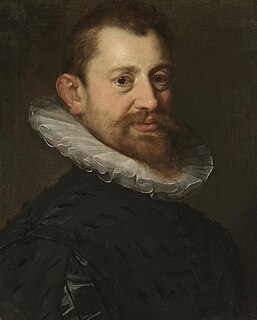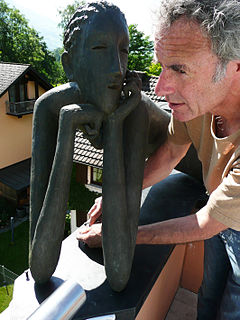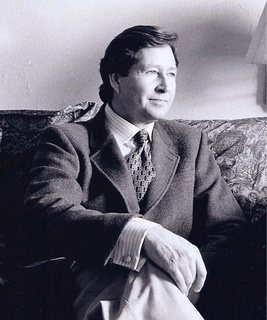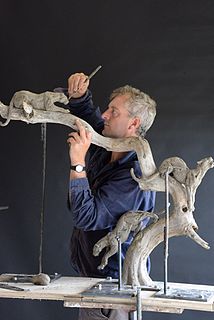
Hiram Powers was an American neoclassical sculptor. He was one of the first 19th-century American artists to gain an international reputation, largely based on his famous marble sculpture The Greek Slave.

Adriaen de Vries (c.1556–1626) was a Northern Mannerist sculptor born in the Netherlands but working in Central Europe, whose international style crossed the threshold to the Baroque; he excelled in refined modelling and bronze casting and in the manipulation of patina and became the most famous European sculptor of his generation. He also excelled in draughtsmanship.

Nancy Graves was an American sculptor, painter, printmaker, and sometime-filmmaker known for her focus on natural phenomena like camels or maps of the Moon. Her works are included in many public collections, including those of the National Gallery of Art, the Brooklyn Museum of Art, the Smithsonian American Art Museum, the National Gallery of Australia (Canberra), the Des Moines Art Center, Walker Art Center (Minneapolis), and the Museum of Fine Arts. When Graves was just 29, she was given a solo exhibition at the Whitney Museum of American Art. At the time she was the youngest artist, and fifth woman to achieve this honor.
Demétre Haralamb Chiparus was a Romanian Art Deco era sculptor who lived and worked in Paris, France. He was one of the most important sculptors of the Art Deco era.
Allan Capron Houser or Haozous was a Chiricahua Apache sculptor, painter and book illustrator born in Oklahoma. He was one of the most renowned Native American painters and Modernist sculptors of the 20th century.

Rowan Fergus Meredith Gillespie is an Irish bronze casting sculptor of international renown. Born in Dublin to Irish parents, Gillespie spent his formative years in Cyprus.

Albert Paley is an American modernist metal sculptor. Initially starting out as a jeweler, Paley has become one of the most distinguished and influential metalsmiths in the world. Within each of his works, three foundational elements stay true: the natural environment, the built environment, and the human presence. Paley is the first metal sculptor to have received the Lifetime Achievement Award from the American Institute of Architects. He lives and works in Rochester, New York with his wife, Frances.
Hanna Jubran is a Palestinian Arab Israeli sculptor, born in Jish, the upper Galilee. His work addresses the concepts of time, movement, balance and space. Each sculpture occupies and creates its own reality influenced by its immediate surroundings. The work does not rely on one media to evoke the intended response, but takes advantage of compatible materials such as, wood, granite, steel, iron and bronze.
Christian Petersen (1885–1961) was a Danish-born American sculptor and university teacher. He was the first permanent artist in residence at a U.S. college or university, and he is noted for the large body of sculpture associated with a single place, Iowa State College, now Iowa State University.
Gary Freeman (1937–2014), is an American sculptor from Indianapolis, Indiana. He is Professor Emeritus of Indiana University-Purdue University Indianapolis (IUPUI) and served as head of the Herron School of Art Sculpture Department for 33 years, from 1968 until his retirement in 2001.

Boaz Vaadia was an Israeli–American artist and sculptor who worked primarily in stone and subsequently by casting in bronze. Based in New York City since 1975, his studio is located in Brooklyn. The power of natural materials and the relation of human beings to that power determine the content of Vaadia's sculpture. Vaadia said of his work, "I work with nature as an equal partner. The strongest thing I address is that primal connection of man to earth. It's in the materials I use, the environments I make, and the way I work."
Bruce Beasley is an American abstract expressionist sculptor born in Los Angeles and currently living and working in Oakland, California. He attended Dartmouth College from 1957–59, and the University of California, Berkeley from 1959-62 where he earned his BA.

Scott Myers is an American painter and sculptor who lives and works in Texas. He graduated Texas A&M University in 1984 with a doctorate in veterinary medicine. He studied sculpture throughout Italy focusing on Florence, Venice and Rome. Sculpting in Tuscany, he cast his work in bronze at the prestigious Fonderia d'Arte Massimo Del Chiaro in Pietrasanta. In 1994, Myers became an elected member of the National Sculpture Society. On February 12, 2011, Myers was featured in the popular television show Texas Country Reporter. Myers was inducted in the inaugural class of the Haltom City High School Hall of Fame on March 10, 2011.

Lee Harold Letts, American artist, sculptor, painter and goldsmith, is primarily known for his bronze sculptures of birds and animals. His practice is based on the principles of traditional studio craftsmanship, as well as the importance of studying under a master in the manner of the American artists who studied at the École des Beaux-Arts in Paris. The beauty of nature is the primary theme of his artwork. He holds a unique position as a bronze sculptor trained as a goldsmith.
Richard Trupp is a British sculptor who specialises in large-scale works. He was a student of the late Sir Anthony Caro.

Hamish Mackie is a British wildlife sculptor who works in bronze, silver and any other castable metal using the lost-wax casting method. He is considered to be one of the world's foremost wildlife sculptors. Largely self-taught, Mackie captures his subjects - ranging from livestock to birds via wild animals - by observation in a natural environment, taking detailed photographs and sometimes modelling in plasticine. From this he creates a highly accurate anatomical core covered with a loose, almost impressionistic skin that captures the essence of the animal's personality. He has won numerous commissions including works for Jilly Cooper, Charles Saatchi, Ronnie Wood (private) and RSPCA, National Trust, Woburn Abbey, Merrill Lynch, Hiscox and most recently the Berkeley Group Holdings (public). He has travelled to places including Antarctica, the Falkland Islands, Australia, across Africa, and the United Arab Emirates in search of subjects.
Alfred Barye "Le Fils" or Alf Barye was a French sculptor, of the Belle Époque, pupil of his father the artist Antoine-Louis Barye. In cooperation with Émile-Coriolan Guillemin, Barye did the artwork for "The Arab Warrior Knight on Horseback". Included in Barye's oeuvre were animalier bronzes as well as Oriental subjects. At his father's request, he signed his work as "fils" to differentiate his work from his father's.

Ivor Abrahams was a British sculptor, ceramicist and print maker best known for his polychrome sculptures and his stylised prints of garden scenes. His career long exploration of new subject matter, novel techniques and materials made his art dealer, James Mayor, describe him as Europe's equivalent of Robert Rauschenberg.
William Ernst Ehrich was an American sculptor, ceramicist, public monument artist, educator, and Work Progress Administration (WPA) supervisor.

Stuart Nigel Reid Wolfe is a British actor, circus acrobat, sculptor, painter and designer who lives and works in Berlin, Germany. Wolfe is known for his political and mythological bronze sculptures as well as bronze furniture series. His sculptures Figuren gegen das Vergessen were permanently installed at the memorial centre Mahn- und Gedenkstätte Ravensbrück of the former concentration camp near Berlin in 2006.











